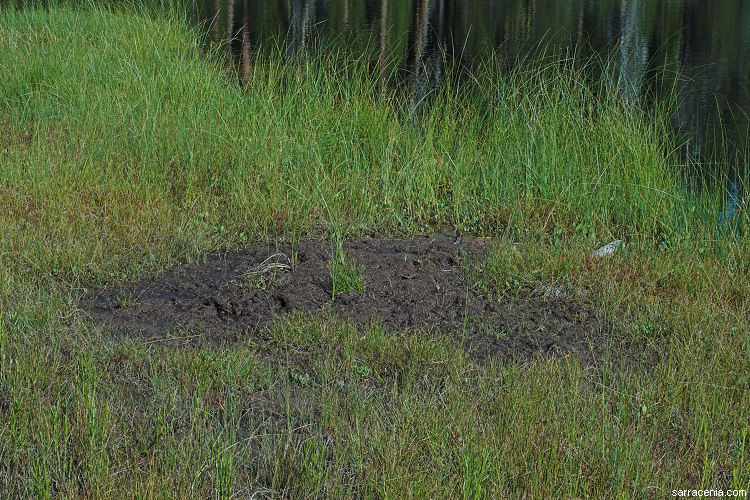
Peat structure:
I was greatly interested in the Utricularia at this lake,
so I spent several hours slowly patrolling the area scouring for plants.
The open-water part of the lake was oval in outline.
Its perimeter was bound by the thick floating Sphagnum mat that was sometimes many tens of meters in breadth.
This mat (i.e. the false lake bottom) is where the Drosera anglica occurred in great numbers.
Exterior to the mat zone was a region of water a few cm to a meter deep, populated with emergents: usually
Carex, but also other monocots such as Typha (cattails). This region was a true lake bottom,
although often very deep with muck. Leeches, of course, were common wherever there was open water.
Exterior to the true lake bottom zone, the shore rose quickly and solid ground finally appeared.
Here's something interesting I saw as I surveyed the lake.
In a few places the Sphagnum mat had bizarre rips, where the mat
seemed to have been torn and churned, with fresh peat brought up to the surface (see above photo).
I first thought this might have
been mechanical damage caused by an animal, or more likely a clueless person or a dork messing with the
delicate structure of the peat mat. However, there were no tracks or other telltale marks in the muck that would
presumably be left by a person's passing.
I then considered that these features may have been caused
by frost heaves--but surely they would have been colonized by more plants, since it was late July. My current
and favorite theory is that these rips were caused by upwellings of peat driven by methane gas generated by decomposing
submerged material. I pushed my walking stick (oh, you have to have one or two of these to probe the ground in front of you
when bog-walking) into the muck, and it met no resistance at all. Step on one of these subtle traps on the peat mat,
and you'll plunge in to your neck! A definite hazard to be aware of!
I was investigating one of these rents in the mat when I saw a bit of half-exposed trash. In irritation
I used my stick to drag it to me so I could pack it out with me. As I brought it to my eyes
I discovered with a shudder that it was a wallet! I opened it (damn, it wasn't stuffed with a vast sum of money) and
by looking at its dated contents I found it had been in the lake since 1992--14 years ago!
I looked at the picture on the old driver's license in the wallet, and wondered if poor "Don F"
had spent the last
14 years submerged in this lake--what did he look like? Was he completely reduced to bones,
or was he preserved as beautifully as a European
bog person? I probed into the peat-rip with my stick but didn't turn up any bones or bits of cloth. No corpses today!
It was creepy, standing in front of this hole in the bog-mat, looking through the contents of an old wallet. Along with
the driver's license there were
family photos--mostly obliterated by oozing bog water--a fishing license, a business card, and other personal effects. Was
Don F underneath me somewhere, nought but a leech condo? Were the family members still wondering
what happened to him?
And if I told the police about my find, would they come looking for Don's remains, with huge dredges that would tear
up the spectacular Sphagnum mat?